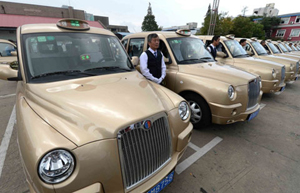In Gothenburg, near the company's headquarters, Volvo has built a driverless car research center and set up 50 kilometers of roadway for self-driving road tests in 2017.
As part of the Drive Me project, the company will lease the self-driving cars to select Volvo customers, and "they can use the self-driving function on a 50 km long road which is designed and selected for self-driving," Coelingh says.
During a recent visit to Volvo headquarters, a few cars with the self-driving function were ready for road tests.
The prototype cars are loaded with cameras, sensors and radar, and equipped with a GPS map system. Company officials expect to simplify the prototype, which relies on multiple detection devices and technologies to make the auto-driving function work.
The GPS and map system locate the position and speed of the car on the road. Sensors and radar are used to detect objects near the car and, based on that, send instructions to make a turn, brake or accelerate.
For our test drive, Coelingh drove a blue self-driving car to a section of public road and pushed a button on the steering wheel when we entered the test area. A computer in the car's boot collects data from the road and satellites, and then calculates the distance to the car in front of us and to cars in lanes on either side to keep the car moving on the right track.
After hitting the button, Coelingh took his hands off the steering wheel and put them on his knees.
"We started to test self-driving cars on this road this spring. Sometimes it was really interesting to see other people's reaction when they saw my hands off the wheel."
We passed through a tunnel, and while the GPS lost the signal, it does not affect the car's auto-drive function.
"For a short time, this disconnection is OK. But it will cause problems if the disconnection time is too long," he says.
Coelingh does not allow the self-driving car to change lanes. But he says that by 2017, the cars would be able to reach a speed of 70 km/h.
Plans call for construction of an autonomous car park by 2017 to make full use of the technology. The project and research leading up to it will have cost around 500 million kronor ($69 million) between 2000 and 2017.
Autonomous parking will increase space efficiency and make it possible to use less attractive areas for parking, Coelingh says. "You can park many more cars in the same area, like you can fit more cars on the road through self-driving technology."
In a computer demonstration video, the self-parking system finds the best location through a cloud computing system and drives the car without a driver to a parking space.
"When I experienced sitting in one of Volvo's self-driving cars, I was absolutely convinced that autonomous drive will open up fantastic possibilities," Samuelsson says. "The driving will be safer, more sustainable and I can manage my own time if I want to."
|
 |
 |
| Shanghai launches old-style cabs for special needs | Top 5 offshore renminbi investments |
